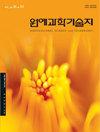Foliar application of micronutrients enhances growth, flowering, minerals absorption and postharvest life of tuberose (Polianthes tuberosa L.) in calcareous soil
IF 0.8
4区 农林科学
Q3 HORTICULTURE
引用次数: 1
Abstract
Micronutrients applications are effective for better crop production in calcareous soils because these soils are usually deficit in iron (Fe), zinc (Zn) and boron (B). In Pakistan, most of soils are calcareous in nature. When tuberose is grown in such soils as a cut flower, its production is negatively affected. Therefore, a study was aimed to evaluate the effects of micronutrients as foliar sprays on cut tuberose production in calcareous soil. Micronutrients (Fe, Zn and B) alone and in combinations were sprayed on the plants after 60, 90 and 120 days of planting. The mixture of all these three micronutrients increased the plant height (95.77 cm), chlorophyll content (38.13 SPAD), number of leaves (79.63), leaf length (44.73 cm), fresh (111.64 g) and dry (16.16 g) plant weights, root length (15.13 cm), number of stalks (3.73), stalk length (79.03 cm), spike length (22 cm), number of florets (51.67), floret fresh weight (11.85 g), leaf Zn concentration (53.6 mg/g) and vase life (8.4 days). Fe + Zn enhanced the number of leaves (76.60), leaf length (45.83 cm), root length (15.05 cm), spike length (22.33 cm), and leaf Fe (128.18 mg/g) and Zn concentrations (55.02 mg/g). The Fe spray increased the leaf length (44.10 cm), days to flower initiation (142.47 days) and leaf Fe concentration (130.75 mg/g) in tuberose plants. Application of Zn improved the leaf length (45.87 cm) and diameter (1.32 cm), root (15.03 cm), spike (21.77 cm) and floret lengths (4.74 cm), floret dry weight (1.49 g) and leaf Zn concentration (57.5 mg/g). Foliar spray of B increased the B concentration (21.1 mg/g) in tuberose leaves. It is concluded that foliar application of micronutrients alone and in combinations improved the plant growth, flowering, leaf minerals concentrations and vase life of tuberose spikes. However, mixture of Fe, Zn and B was more effective as compared to other treatments. Moreover, current study encourages the foliar application of micronutrients in tuberose when grown in calcareous soils.在钙质土壤中,叶面施用微量元素促进了马铃薯的生长、开花、矿物质吸收和采后寿命
在钙质土壤中施用微量营养素对提高作物产量是有效的,因为这些土壤通常缺乏铁(Fe)、锌(Zn)和硼(B)。在巴基斯坦,大多数土壤本质上是钙质的。当晚香菇作为切花在这样的土壤中生长时,它的生产受到负面影响。因此,本研究旨在评价微量营养元素叶面喷施对钙质土壤中块茎切花产量的影响。在种植60、90和120 d后分别单独和组合施用微量营养素(铁、锌和硼)。3种微量营养素混合施用后,植株高(95.77 cm)、叶绿素含量(38.13 SPAD)、叶片数(79.63)、叶长(44.73 cm)、鲜重(111.64 g)和干重(16.16 g)、根长(15.13 cm)、茎数(3.73 cm)、柄长(79.03 cm)、穗长(22 cm)、小花数(51.67)、小花鲜重(11.85 g)、叶片锌浓度(53.6 mg/g)和瓶期(8.4 d)均显著增加。Fe + Zn处理提高了叶片数(76.60)、叶长(45.83 cm)、根长(15.05 cm)和穗长(22.33 cm),提高了叶片铁(128.18 mg/g)和锌浓度(55.02 mg/g)。铁喷施后,叶片长度增加了44.10 cm,开花时间增加了142.47 d,铁浓度增加了130.75 mg/g。施锌提高了叶片长(45.87 cm)、直径(1.32 cm)、根长(15.03 cm)、穗长(21.77 cm)、小花长(4.74 cm)、小花干重(1.49 g)和叶片锌浓度(57.5 mg/g)。叶面喷施B提高了结核叶片中B的浓度(21.1 mg/g)。综上所述,叶面单施和配施微量营养元素均能促进植物生长、开花、叶中矿物质浓度和块茎花瓶寿命。但铁、锌、硼混合处理效果较好。此外,目前的研究鼓励在钙质土壤中生长的块茎叶面施用微量营养素。
本文章由计算机程序翻译,如有差异,请以英文原文为准。
求助全文
约1分钟内获得全文
求助全文
来源期刊
CiteScore
2.00
自引率
0.00%
发文量
0
审稿时长
1 months
期刊介绍:
Horticultural Science and Technology (abbr. Hortic. Sci. Technol., herein ‘HST’; ISSN, 1226-8763), one of the two official journals of the Korean Society for Horticultural Science (KSHS), was launched in 1998 to provides scientific and professional publication on technology and sciences of horticultural area. As an international journal, HST is published in English and Korean, bimonthly on the last day of even number months, and indexed in ‘SCIE’, ‘SCOPUS’ and ‘CABI’. The HST is devoted for the publication of technical and academic papers and review articles on such arears as cultivation physiology, protected horticulture, postharvest technology, genetics and breeding, tissue culture and biotechnology, and other related to vegetables, fruit, ornamental, and herbal plants.

 求助内容:
求助内容: 应助结果提醒方式:
应助结果提醒方式:


